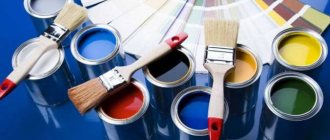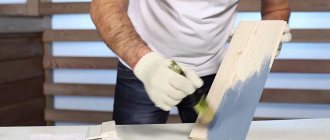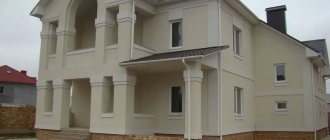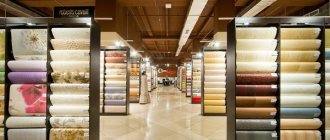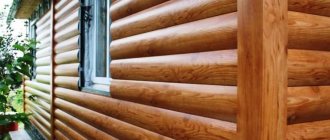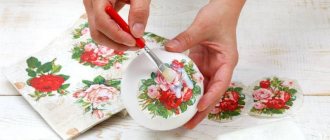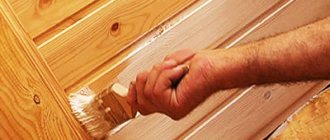Factory quality processing
Any defense has its limits, no matter how advanced methods it is carried out, time will destroy it.
Most companies that produce block houses take care of the reliability of their products, selecting only the best examples. Before releasing parts, manufacturers do not forget to coat the outside of the block house with protective liquids and properly impregnate it with various protective agents. After impregnation, it is not afraid of heat, cold and other weather vagaries, which can not only harm, but destroy the protective layers.
A high-quality block house is already impregnated at the factory
You shouldn’t doubt the quality of the treatment yourself; it’s better not to do anything until the protective layer actually begins to deteriorate. Fortunately, factory-made products can last for more than a decade without additional processing, replacement or repair, so you should only worry about their integrity in incredibly extreme conditions.
Results
If you already know how to paint a block house on the outside and how to paint a block house on the inside, you need to pay attention that these are different types of work.
When starting to paint the exterior, you need to check the weather forecast. The weather should be dry and preferably warm, which will allow the paint to dry in the shortest possible time. Before starting work, the wood should be prepared: cleaned and bleached.
After cleaning, the surface must be primed. To ensure that the paint is distributed evenly, you need to start painting from the top.
- Painting inside.
For interior painting, a more decorative coating, without deep impregnation, is more suitable. Typically, for such purposes, colorless varnish, glossy or matte paints are used, approximately the same shade as the block house itself. Impregnations are also applied shallowly and in one layer. In order for the paint to “take root” well, the inner surface should also be primed.
Treatment of unimpregnated block house
Perhaps you were lucky enough to purchase a block house without impregnation. Then it will need to be treated with several liquids that will improve its quality and protect it from insects, fungus and mold.
If you are wondering how to treat the outside of a block house, one of the simplest options is to cover the entire surface with varnish. It is worth considering that such protection is not complete and cannot even be compared with impregnation. A layer of varnish will last no more than two to three years, taking into account mild weather conditions. After the first layer becomes unusable, it will be necessary to clean the block house from the old varnish in order to apply a new one. Therefore, this method should be used only if there are no other options.
Dark impregnations look best on the outside
The highest quality treatment of a blockhouse outside the building is carried out with special liquids that are designed to protect the wood from adverse conditions. Impregnation is an excellent means of protection here. Moreover, it is worth trying various impregnations to improve the mechanical qualities of the wood. There are many different ways to ensure good protection of a wooden structure by impregnation:
- To protect against rodents and other possible mechanical damage, it is recommended to use alkyd impregnations. They have a rather pungent odor, so the processing process should be carried out in a separate room. This type of impregnation will improve the mechanical properties of wood for a very long time.
- To improve the decorative properties of a block house, it is recommended to use impregnating oil liquids with tinting. They will help maintain the initial appearance of the structure for a very long time, and they also emphasize the texture of the wood.
There are special acrylic water-soluble impregnations. They do not have a pungent odor and do not emit toxins, so they are most often used to treat interior linings, but they are not durable.
Processing of block house at the installation stage
To protect the exterior of carpentry, preserve their external beauty and extend their service life, it is recommended to treat them with paints and varnishes before starting installation work. For these purposes, all kinds of stains, varnishes, paints, glazes, impregnations, drying oils, etc. are used.
How to cover a block house if preference is given to the natural structure of wood? Transparent varnishes and glazes will help in this matter, while tinted opaque paints, on the contrary, will hide all the imperfections of the wood and fit into the style invented by the author.
Impregnations are used to protect wood from fire, bad weather and pests.
- Water-soluble acrylic impregnations are intended for coating fresh wood, do not have a strong toxic odor and can be used for painting indoor surfaces, even while residents are living.
- Alkyd impregnations based on resins create a more resistant, durable and high-quality coating, but have a pungent odor and are intended for outdoor use.
- Oil products are made on the basis of flaxseed oil (or any other natural oils). A durable coating that has long been time-tested, but takes quite a long time to absorb and dry. After oil impregnation of the house block, decorative finishing with some paints will be impossible!
Stains leave the grain of the wood unchanged, but change its shade, usually to give the color of a different species. It is applied to the treated surface, penetrates inside, dries without forming a film or smooth layer on the outside of the surface.
Stains can be water-based, solvent-based (nitro stain), wax-based, or alcohol-based. The latter almost always have protective qualities. You can also paint the block house with a colorless stain, which is intended solely to protect the wood and the primer.
Expensive processing
To protect a new design from most risks, it is necessary to use only proven and best materials.
Don't know what to paint the outside of a blockhouse with? One of the most popular methods is the use of azure. This special composition can be mixed with the tint and then applied to the wood surface.
Unfortunately, it is quite difficult to accurately guess the shade that will result, but it is guaranteed to change the color of the wood. It is better to conduct several experiments before using such a mixture on the main structure. In addition, glazes perfectly protect wooden structures, give expressiveness to the texture and withstand various temperature and weather influences for a very long time.
Types of protective coatings
How can you paint the outside of a block house? There are several types of compounds intended for processing. It is better to cover wooden products with stain, varnish, drying oil, impregnation, paints and glaze.
Impregnations
In order to preserve the beautiful appearance of the facade for as long as possible, it is necessary to correctly select and apply an impregnating composition to the surface of the house block. There are several types of such material:
- Acrylic based. Odorless, applied to untreated wooden surfaces, can be diluted with water. Such impregnation can be used both outside and inside the house.
- Based on alkyd resins. Used for outdoor work, it gives the log covering strength and durability.
- Oil compositions. They are used exclusively for facade painting of block houses, since the composition is toxic and has a pungent odor.
Before using oil impregnations to process block house, make sure you have a respirator and rubber gloves to protect your skin and respiratory tract from toxic fumes of the material.
On the video: types of wood impregnation and nuances of choice.
Azure
Most builders recommend treating the block house with a compound that forms a waterproof thin film on the surface. And this is azure. It can be decorative (imitates different types of wood) or transparent. With its help, you can protect your block house from chemical and climatic influences, as well as preserve the natural texture of the wood.
Wood glaze is available in a wide range of shades, gives the facade clarity and expressiveness, and protects from UV rays.
The composition of the glaze may include alkyd, acrylic, acrylic-oil, alkyd-urethane substances. They allow you to remove minor chips and cracks from the surface that may have appeared during work. The material penetrates deep into the damage, filling all the voids that appear. The composition can be used to coat blocks both indoors and outdoors.
Paints and varnishes
Painting a house block can be done either with paint or varnish. Such paints and varnishes create a thick barrier layer on the surface that protects the material from negative environmental factors. In addition, blockhouse paint is a good choice if you want to hide some imperfections in the wood or completely repaint it.
Varnishes are usually colorless, but there are also options that can change the shade of the wood. Despite all the advantages, the material applied to the surface may begin to crack and peel after some time. To refresh or replace it, you will have to clean the wood from the old coating, prime the logs and only then apply a new layer.
Treating a house block with wax is a completely traditional way to protect wood. The wax texture is evenly distributed over the log surface, creating a water-repellent and light-resistant matte finish. It is best to apply the material to internal surfaces, that is, when the log blocks are laid out indoors.
Wax is often applied to a painted house block. This way you can give the paint a natural shine and protect the coating from destruction.
Painting a block house
If you really want to radically change the color of the block house, you can paint it in the color that you like. But before you paint the outside of the blockhouse, you should take care of the cleanliness of the surface. The entire wood part needs to be cleaned of previous coatings using sanding machines, a knife, in general, anything that can be used to remove the old layer. After completing the cleaning process, using a roller, begin painting the building. It is best to use a mixture of several layers of paint to make it more durable.
The painting method is chosen depending on the room
For painting, regular wood paint will do, but don’t forget that blockhouse paint is not necessary. If such a structure is painted, the wood texture will no longer be so attractive, and it will not be possible to return everything back.
Manufacturing processing
Most manufacturers who produce block houses for exterior wall decoration try to improve its quality as much as possible. For this, various coloring, antiseptic and water-repellent impregnations are used.
The entire processing process takes place in large industrial machines (pressure chambers), since it is quite difficult to do such work manually. This technology allows the composition to penetrate deep into the wood and maximally protect the building material from fire, rot and harmful insects.
The production processing of a block house is divided into several stages:
- First, the manufacturer chooses what to paint the block house with; this can be either impregnation or a decorative coating, for example, paint.
- This is followed by the displacement of moisture and air from the prepared wooden blocks using a vacuum apparatus.
- After complete drying, a reagent enters the chamber, which will serve as protection for the building material. Under high pressure in a pressure chamber, the logs are impregnated with the composition (the exposure time is selected individually for each type of wood). The depth of impregnation is observed in accordance with established GOST.
- Excess protective impregnation is removed from the chamber, and the house block is subjected to repeated vacuum treatment. In this way, residual moisture can be removed from the surface.
- At high atmospheric pressure and temperature, the protective coating dries completely and is fixed on the blocks.
If you plan to cover the façade of your house with a block house yourself, professionals recommend choosing panels that have already been treated with a protective compound. They are easy to install on the wall surface and do not require additional painting.
Final verdict
For factory products, there is no need to carry out any special procedures to improve the quality of wood. All the necessary impregnation for the block house has already been carried out and there is no need to do it again.
If you have obtained parts for a block house without treatment, you will need to carry out an impregnation procedure with special means that will protect the wood from the destructive effects of moisture, small pests, heat, and cold. True, such protection will be many times weaker than the factory one.
There is no particular need to paint the block house, so it is worth choosing the most suitable shade of wood at the purchase stage. The paint itself can spoil the style created by unpainted wood and destroy the created composition.
What materials are used to cover a block house?
There is a whole series of impregnations and glazes designed to give wooden surfaces improved properties. Manufacturers most often imbue modern materials with a range of properties. They protect wood from:
- influence of ultraviolet rays;
- harmful effects of precipitation;
- penetration of wood-boring insects;
- the appearance of dampness, putrefactive bacteria, fungi.
If the block house needs to be painted to give a certain color shade, then for this purpose, impregnations containing pigment and oils are purchased. The basis for painting materials is:
- Alkyd, giving the paint high durability and long service life.
- Acrylic water-soluble, has a very low odor. This is a good choice when solving the problem of how best to cover the block house inside the house.
- Oilseed oil is usually made from linseed oil. Easy to lay on the surface, suitable for outdoor use.
Glazing paints, thanks to their complex properties, are able to cover wood with a smooth, uniform layer, without smudges. They can create a matte or glossy surface. They enhance the impression of wood patterns by being absorbed into the wood. At the same time, they give it a beautiful tone without taking away the opportunity to “breathe.”
It is better to completely impregnate the block house before installation. If treated material is used, decorative finishing is applied after laying the facing strips.
In addition to impregnations and glazing compounds, there are special paints for wood. They are produced on a water basis, as well as using synthetic or organic solvents.
To cover or not to cover?
The price of a blockhouse depends not only on the species and type of wood. By purchasing beautiful and inexpensive material at the nearest sawmill, a happy buyer will most likely pay extra for the savings a little later, choosing compounds to protect it. The more expensive, factory-made version of the house block is often sold with protective impregnation, which not only frees the owner from headaches in the first years, but also significantly improves the physical properties of the material.
Industrial impregnation of a house block is carried out using unusual brushes and spray guns. The material is placed in an autoclave, where first the residual moisture is extracted from the capillaries of the wood by vacuum, then an antiseptic composition is injected under pressure, impregnating the wood to a certain depth, after which the excess liquid is sucked out again and the wood is dried. This processing method allows the structure of the material to be etched almost entirely, which is why even the cheapest and softest types of wood acquire premium qualities. Factory treatment will provide the blockhouse façade with several years of protection without additional measures.
Selection rules
When buying a block house made of wood, you should not save money if you want to make a beautiful facade that will last for many years. Therefore, we pay attention to the following points:
- type of wood – lumber from softwood raw materials is suitable for exterior finishing;
- material class - extra or class A are predominantly chosen for the facade;
- packaging – the canvas must be packaged and have the same length and width;
- the absence of any defects on the surface of the block house - this includes mechanical damage, blue spots, gaps or cracks, tar stains, curvatures;
- quality of board drying.
If the material meets all the points, feel free to buy it.
Products with transparent texture
Thus, the answers to the question of how to paint a block house outside and for interior decoration can be very different. All products have their own advantages, all have nuances of application. And only after studying all the available options can you begin to change the “appearance” of the room.
Ekaterina Nevzorova, Minsk, 2014
- Should you choose wooden decorative panels? Or should you still choose a vinyl block house for a log? This question arises before everyone who decides to cover the facade with cladding...
- A metal block house under a log is made of galvanized metal. Using special technologies, it is coated with a special polymer...
- Insulation of the walls of a house from the outside is necessary, regardless of the material used (wood, foam block, brick, reinforced concrete, and so on). To complete this process, in any case, you must...
- Houses made of wood are buildings that are distinguished by their reliability, aesthetics and environmental friendliness. Despite the simplicity and naturalness of the material, structures made from it are quite expensive and affordable...
- Once upon a time, there was only one answer to the question of what kind of block house there is. At the dawn of their existence, the panels were exclusively made of wood, and only then they began to be made...
Modern finishing material block house can be used both for exterior decoration of the house and for decorating the interior, creating the illusion of a log house. Typically, manufacturers coat the block house with various protective agents - it becomes resistant to adverse environmental influences and does not require treatment for decades. But sometimes on the construction market you can find material that has not been treated with protective compounds. If you are “lucky” to purchase just this one, then you need to select a high-quality impregnation for the block house.

